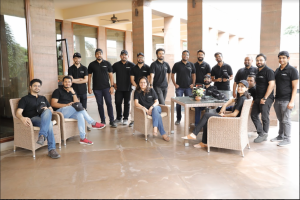Soham Chokshi, Chief Executive Officer, Shipsy, talks us through the inception of the company and how technology is crucial to the success of logistics and supply chain
Q: Tell us about Shipsy and the idea behind this platform.
Shipsy, founded in 2015, is a SaaS company focused on the logistics tech space. We work very closely with retailers and logistics and manufacturing companies. The platform helps all these companies get visibility of all their shipments, reduce costs, and automate a lot of the manual processes, leading to much superior customer experience.
In a world where each of us as end-consumers really want our deliveries to happen quickly, even in 10 or 15 minutes, the expectations have gone high. This has put a lot of responsibility on all the players, whether it be the logistics company delivering the goods, or the retailer selling it, or the manufacturing company supplying the goods. What technology does is meet these expectations, but at a reasonable cost.
And that is where a company like Shipsy comes in. What sets us apart is our ability to merge different scenarios such as stocking, warehousing, and delivery of goods, especially right from 10-minute delivery to three-to-five-day delivery, on to one platform. The other differentiator is the fact that we also combine information on container space, helping retailers manage shipments across both shipment legs.
Ever since the pandemic hit, there’s been this huge push towards direct-to-consumer and faster deliveries. This has had let to high expectations. And this has been really fuelling our growth in a big way.
In terms of the company itself, we have offices across Dubai and India, we have a large customer base across the Middle East mainly in Dubai, Saudi Arabia, Egypt, and Kuwait. We also operate in Southeast Asia. Financially, we’re backed by Sequoia Capital.
Pan Emirates, Aster DM Healthcare, Gulf Marketing Group, Zajil, Flow Progressive Logistics, Saab Express, and Sun & Sand Sports to name a few are our clients in the Middle East.
Q: Why logistics?
Logistics is a multi-trillion-dollar market and is still largely under penetrated. When we launched our platform in 2015, eCommerce was on the rise in India, and we saw the expectations customers had from this sector. Our research revealed that most of the systems companies used were in-house platforms, and not really made for the new age customer.
So, we built a platform for the supply chain and logistics sector that integrates all the essential processes into a single system – a programme that connects the retailer with the logistics company, the manufacturer, the driver, and the end consumer all together on one single technology platform. The big driving factor for us was the size of the opportunity and the value we could create.
 Q: How has your journey been so far?
Q: How has your journey been so far?
It’s been extremely fulfilling. What we really pride ourselves in is that large enterprises have trusted us with their logistics. Especially in India, the country’s largest retailer – Reliance Retail has its entire distribution powered by Shipsy. Other customers include, DTDC, Domino’s Pizza and Zepto, a 10-minute grocery delivery app in India.
Similarly in the Middle East, especially Saudi Arabia, conglomerates have entrusted us with their distribution. A crucial change we’re witnessing is how large enterprises are putting their trust and faith in start-up companies, like us, for something as critical as logistics.
If you’re a company that is selling goods, a very large portion of your responsibility is to get those goods to customers in the best possible manner. We are glad to be part the shift where large firms are entrusting start-ups with critical responsibilities, and to be educating customers to explore platforms like ours and see the benefits of implementing software company platforms.
Q: Compared to India, what makes the Middle East a key market for Shipsy?
While India is our large market, the Middle East comes pretty close in terms of revenue contribution. We entered this market in 2019 when a few our clients began dealing with firms in this region. Through that network we got introduced to customers in the region. As a start-up we’re grateful for the business we’ve received from the region and the trust customers have had in our product.
Retail has been one large area of interest for us. When we started it was more around furniture, apparel, and electronics, however over the last year or so the whole hyperlocal logistics has come to the fore. Food, grocery, and medicine companies are adopting these platforms for quick and hyperlocal deliveries.
The pandemic has further accelerated our business. Companies who were unsure about digitisation prior to the pandemic have now fully digitally integrated their business.
Q: How has the supply chain crunch impact your business?
Here’s where visibility has become crucial. When container supply starts getting scarce, every container coming in becomes very valuable. As a customer, you would want to know exactly where the container ship is, when it is going to arrive, if it is delayed, how long is the delay going to take, and how those feed into your supply chain, etc. So, essentially as supply becomes limited customers want more visibility.
Additionally, because of the high freight rates and the variation in rates a digital platform is required to provide price comparison and visibility in real time. The past two years has been a great learning curve for us, and we’re extremely thrilled to have served our customers well.
The larger driving force, post the pandemic, has been this massive need for all retailers and logistics companies to build their direct-to-consumer practice. They’ve realised that they need be able to do flexible and deliveries. Two-year plans soon turned into a two-month plan as soon as a pandemic came in.
Q: What’s next for the last-mile delivery sector?
While the deliveries times have reduced to same day and within four to eight hours, consumers are also getting a lot more discretionary. They are looking at sustainability very seriously. Customers want their items delivered in a more sustainable manner whether it be via bicycles or electric vehicles/ bikes. Eco-friendly packaging is another area of focus.
Cost will become a natural driver of push towards sustainability. We’re begin to club orders to reduce the distance travelled, we offer adaptive clubbing, the system automatically starts matching orders that are in the same direction and allocating it to optimise the routes in real time. This really helps one: from a cost and two: from a sustainability perspective. I personally see this going away from our big focus on speed to sustainability.
Q: Is this an opportunity as well as a challenge?
Sustainable practises are always going to be challenging for business. Companies across the globe are focusing reducing their carbon footprint. And logistics happens to be a big contributor to carbon footprint. So how do you measure it, how do you choose better options that are more sustainable in real time and how to deliver to customers in a more sustainable way are some of the questions.
Here’s where a sustainability dashboard comes into play that depicts real time reduction in distance travelled by clubbing orders, type of vehicle used, etc.
Compared to India, I think the Middle East is a little behind in its journey towards sustainability. In India, we see a lot of options in last mile delivery vehicles. Electric vehicles and bicycles are being used for a shorter distance, and a lot more focus on packaging.
Having said that things are changing fast. I didn’t think it would have transformed that quick, but they have. Even in terms of adoption of technology. Companies we thought would take five to six years to onboard latest technologies have done it within a six-month period.
Q: What’s on the horizon for Shipsy?
We have a strong presence in Saudi Arabia, Egypt, and the UAE. We’re looking to expand to the rest of the Middle East – namely Oman, Bahrain, and Qatar. Europe and Southeast Asia is on our radar too. Shipsy will set up an office in Indonesia in a couple of months to serve Indonesia, Philippines, and Thailand.

